'We had to work twice as hard': How the pandemic magnified inequities for Florida's migrant students
This story was produced by Janine Zeitlin, a participant in the USC Annenberg Center for Health Journalism's 2020 Data Fellowship.
Her other stories include:
What is Florida’s plan for vaccinating thousands of farmworkers? It’s unclear
Nikki Fried to Gov. DeSantis: Give Florida farmworkers, all teachers COVID-19 vaccines now
How Florida left farmworkers out of its COVID-19 pandemic response
Florida farmworkers struggled to get vaccinated. But health officials finding ways to help
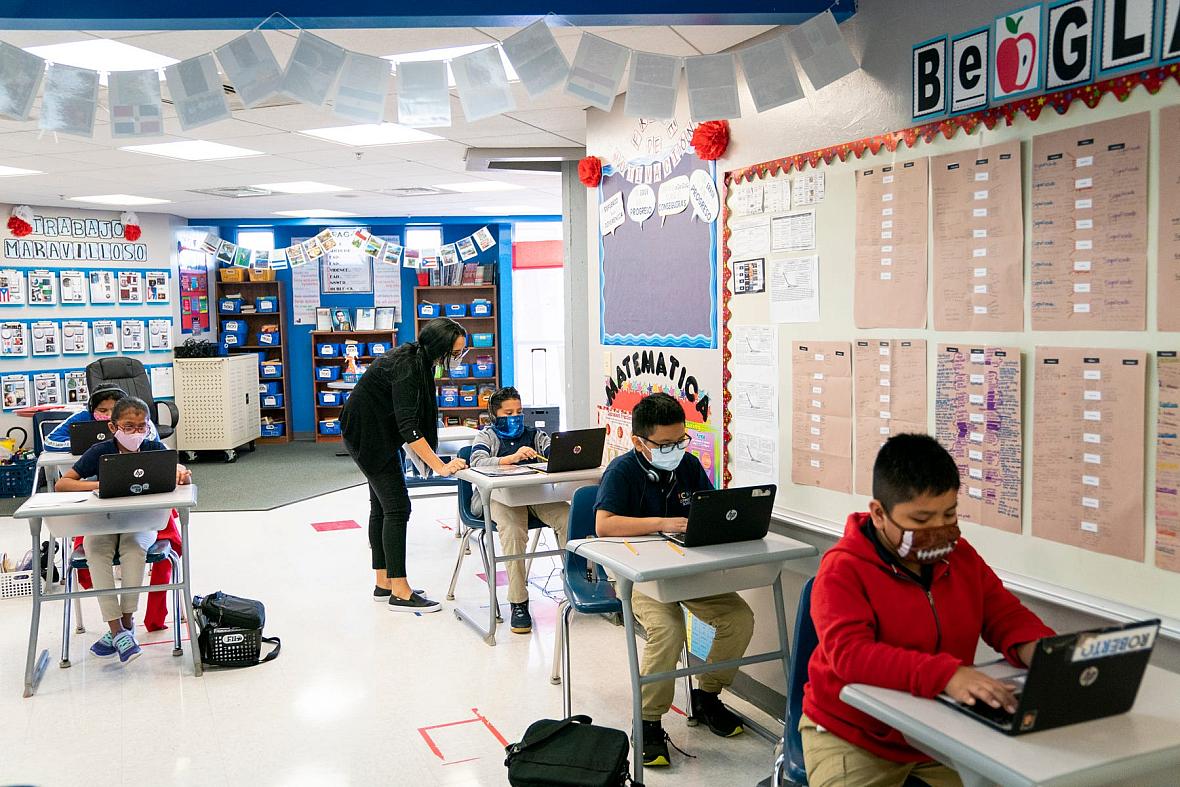
Fifth-grade teacher Uyslamis Echeverria-Ramos helps a student at RCMA Immokalee Community School in Immokalee during an exam in November. Nearly all the students returned to in-person learning for the school year, which Principal Zulaika Quintero says helps the school to keep tabs on students' educational progress and emotional states.
ALEX DRIEHAUS/NAPLES DAILY NEWS/USA TODAY - FLORIDA NETWORK
Brandon Garcia considered the apple tree near his family’s trailer in rural Michigan, where his father worked the blueberry harvest. No connection.
His link to virtual school back in Florida was lost.
“Here I go again,” the 13-year-old sighed.
Brandon shimmied up the trunk and leaned into the fork. He clutched his tablet with its unreliable phone hotspot, hoping the perch would reward him with a stronger signal.
Refresh, refresh, refresh.
When it worked – and mostly it didn’t – the itchy ant bites, a consequence of the climb, distracted him from class. It could be awkward when he had to turn on his camera.
“They were like, ‘Why are you on top of a tree?’”
In his hunt for a better signal, Brandon Garcia, 13, a Plant City migrant student, often took his virtual classes early in the pandemic while perched in this apple tree in rural Michigan, where the family works during blueberry season.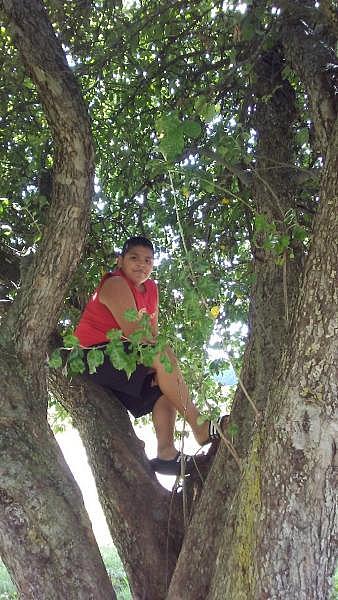
When it worked – and mostly it didn’t – the itchy ant bites, a consequence of the climb, distracted him from class. It could be awkward when he had to turn on his camera.
“They were like, ‘Why are you on top of a tree?’”
Despite his efforts, “it didn’t go really well,” Brandon said. “I had some D’s, some F’s.”
When the family returned to Florida for the fall, school officials strongly suggested he attend in person.
There his grades rose some, but overall it was a very hard year. A grandmother in Mexico he never got to meet in person died of COVID-19. His father contracted the virus while working in Georgia. Though his dad is now vaccinated, Brandon’s unease lingers.
“I feel like if I don’t do my best to try and protect the rest of my family, it could get much more worse and they could pass on,” he said. “I wash my hands with hand sanitizer, but I don’t know if that’s going to be enough.”
Still, Brandon’s school life markedly improved from the start of the pandemic. It’s an encouraging trajectory, the kind migrant educators hope will play out on a broad scale.
A full picture is yet to emerge of the pandemic’s impact on Florida’s migrant students. What is clear: virtual learning, economic trials and high COVID-19 rates in farmworker communities magnified inequities for students already prone to learning loss, according to early data and interviews with experts, advocates and migrant families throughout the state.
Florida schools lost migrant students at a rate nearly five times higher than the non-migrant population, a USA TODAY Network-Florida analysis of Florida Department of Education data showed. Migrant student enrollment fell more than 9%, or about 1,500 students, from spring 2020 to spring 2021, while non-migrant students dipped by 2%, about 60,000 students.
//Migrant enrollment showed sharper declines than other vulnerable groups.
Enrollment among English learners fell 7%, economically disadvantaged students dropped 3% and students with disabilities decreased 2%.
Collier County, home to the agricultural hub of Immokalee, counts the most migrant students in the state followed by Palm Beach, Hillsborough, Miami-Dade and Polk counties. Among those, Palm Beach saw the highest rate of migrant enrollment loss, reporting 13% fewer migrant students, followed by Collier with an 11% drop.
//The lower migrant enrollment figures don’t necessarily mean children aren’t in school. Many families chose not to migrate during the pandemic’s peak. Students may have attended school but weren’t identified as migrants.
“What we know is the crops didn’t change, agriculture didn’t necessarily change, so what’s happening? We’re working really hard to make sure it’s not that they’re here and we just don’t have them in school,” said Francisco Oaxaca, director of multicultural education and migrant programs for the School District of Palm Beach County. “That is our biggest thing right now.”
She picked crops while taking AP classes. Now she's off to college
Among migrant students enrolled, some had spotty attendance. Brandon, for instance, missed class time when he couldn’t log on. Although statewide data is not yet available for this school year, Hillsborough County figures as of April showed a 50% increase over the previous school year in the number of migrant students counting 10 absences or more, compared with a 22% increase among non-migrant students.
Experts anticipate migrant enrollment will rebound but worry students will return to classrooms that won’t meet their unique strengths and needs. Researchers fear vulnerable students won’t be fully represented in test results. This spring, some students migrated north before testing was complete. Migrant programs are pushing project-based, individualized summer programs to accelerate learning.
“There is a large learning gap that was always prevalent in the migrant community. It’s exacerbated now with the pandemic,” said Erica Garcia, executive director of migrant education for Miami-Dade County Public Schools.
“It’s all hands on deck right now.”
Identifying migrants is vital to helping them in school
The data reflects the abnormality of the time.
In recent pre-pandemic years, Florida’s non-migrant student population inched up, on average, 0.5% while migrant enrollment dipped 2.5%, state education data shows.
Migrant programs attributed the decline to growers’ increased reliance on guestworkers, who typically come without children. Former President Donald Trump’s immigration policies scared some undocumented migrant families from schools, which many parents equate with government, officials said.
Florida reported 14,500 migrant students statewide as of this spring, but the most recent federal data reflected several thousand more.
The migrant education program began in the ‘60s, a federal recognition of the pile-on of hardships facing migrants. The government allocates money to states with the goal of helping migrant students reach academic standards and graduate high school. Funding provides for extra educational support, family engagement, records transfers and advocacy for migrant students.
But a critical piece of the program — identifying and recruiting students who qualify — was stymied by the pandemic.
Migrant program officials found food distributions were a good way to find students, whether it was delivering lunches in rural Miami-Dade or bringing food to families in Hillsborough County by partnering with Feeding Tampa Bay.
Community members collect boxes containing food during a homeless count in January hosted by the Collier County Hunger and Homeless Coalition at Guadalupe Social Services in Immokalee. JON AUSTRIA/NAPLES DAILY NEWS USA TODAY NETWORK - FLORID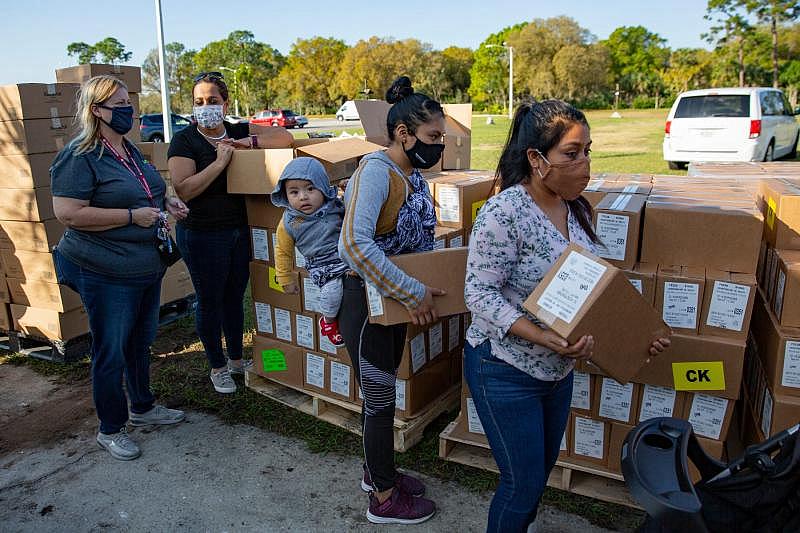
They made phone calls, plastered neighborhoods with door hangers and sent flyers to daycares. But COVID-19 curtailed events and gatherings they relied on, coordinators said. And locating newly arrived migrant families was tougher.
“Identifying the migrants was our biggest barrier because we weren’t able to be out in the community as we were rigorously” before the pandemic, said Marlene Dimas, migrant program coordinator for Collier County Public Schools. Families often “very fluently” transition “between counties and states. They’re here one minute and then they’re gone the next.”
As the virus’ threat waned, Collier and other districts ramped up in-person efforts and found more migrant students in the process. Some were not in school. They didn’t know they had to register “because registration’s online now, which is very difficult for our families,” Dimas said.
The abrupt shift to online schooling exposed cavernous gaps in access.
Out-of-school inequities: digital, language divides
Matilde Angeles felt powerless when her 16-year-old son’s computer froze. He couldn’t send his test; she couldn’t either. She grew frustrated.
What do I do? Who do I talk to?
“I’m not very familiar with technology or the computer,” Angeles, a 51-year-old migrant worker in Naples, said in Spanish. “How could I teach my son if I didn’t know what to do myself?”
She called a Spanish-speaking migrant program specialist, whom she has known for more than 20 years through her two older children. He told her how to get help.
But many migrant families often do not have the habit of advocating for themselves.
“A lot of our families didn’t say, ‘Oh I need this, oh I need that,’” Dimas said. Matilde Angeles, 51, of Naples, migrates with tomato crops. She worried about being able to help her 16-year-old son Francisco Angeles during virtual school because she lacks computer skills. However, her son excelled in virtual school. ANDREA MELENDEZ/THE USA TODAY NETWORK-FLORIDA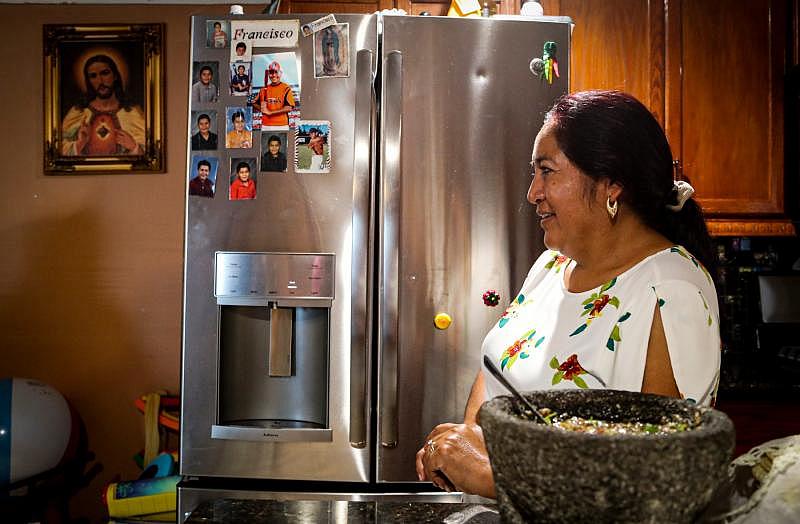
Early in the pandemic, Collier officials discovered parents didn’t know to ask for Wi-Fi access or feared telling staff computers were broken because they worried they’d have to pay for them.
Hundreds of Florida migrant students didn’t log on when schools went virtual.
Not only do migrant students live in rural areas, but their homes can be in remote locations. Miami migrant program officials have found undocumented families living in horse stalls and sheds.
Florida counted more than 800,000 students who didn’t have a fast-enough internet connection, the necessary hardware or sufficient data plans for distance learning. Nationwide, the largest share of students – 37% – with inadequate connectivity were in rural areas, according to a report from the nonprofit Common Sense.
“Even with some of the best efforts, some of the efforts are not really good enough when we’re talking about migrant farmworker families because of their location, lack of access, lack of technology,” said Lourdes Villanueva, director of farmworker advocacy at Redlands Christian Migrant Association or RCMA, which provides education and social services to migrant families in Florida. “This just really showed us how big that gap is.”
Jesus Hernandez and his wife, Julia, both farmworkers in the Plant City area, with their daughters Zaira, 4, Yaretzi, 7, Yareli, 7, and Yulisa, 5. The couple struggled to help their older girls with worksheets sent home when school closed because neither speaks English and homework instructions were in English and their girls don’t yet read. ANDREA MELENDEZ/THE USA TODAY NETWORK-FLORIDA
Many migrant families who did not log on when virtual learning began were found but required one-on-one explanations and home visits to navigate the unfamiliar terrain.
“There’s a communication barrier, even when we translate things into their home language,” said Diana Holden, director of federal, state and competitive grants for Collier public schools. “For families with little to no formal education, there’s a misnomer that we’ll translate a letter in Spanish and they’ll understand.”
On average, farmworkers stop attending school at eighth grade, according to the most recent National Agricultural Workers Survey. The majority are most comfortable speaking Spanish, and 30% do not speak English at all. Many Florida migrant families come from rural Mexico or Guatemala, where the need to work supersedes education. Their first language is often an indigenous one.
Jesus Hernandez found he never really needed English while working strawberry and squash crops in central Florida. His co-workers spoke Spanish or the same Mixtec he also speaks.
But he regretted not learning English when school closed and he became teacher to his 7-year-old twins. After work, he’d spend hours translating worksheets for the girls, using his phone to translate the English instructions into Spanish so he could explain them to his daughters. “I didn’t have another option. My wife doesn’t know how to read or write.”
Homework anxiety kept him up at night.
What am I going to do if they send more packets? Ones with more questions? Longer ones?
The girls returned in-person this fall but can’t read.
“And now I feel guilty, that it’s my fault that because I didn’t get help to learn English, that it’s my fault they’re behind,” said Hernandez, 44.
Older migrant students often navigated the virtual transition on their own and in many cases monitored younger siblings at the same time.
“We had to try harder or work twice as hard. This isn’t easy. We don’t have the same available resources. We don’t have someone to work with us on certain stuff. We really have to tutor ourselves in a way to keep going,” said Guadalupe Cortes, 17, who was a junior this year at Pahokee High in Palm Beach County and pointed out her parents did not finish high school.
“Because of COVID, everything was a lot more stressful because everything was a lot more overwhelming.”
Going forward, Miami-Dade plans to promote computer literacy workshops for parents because officials learned during the pandemic that “to reach the children, it was vital to empower the parents on how to master the devices,” Garcia said.
A pandemic plus: migrant programs found some students and parents preferred virtual meetings
Some older migrant students excelled online and found it easier to manage school and home responsibilities.
“I was able to get everything a lot more organized rather than having just a bunch of papers piled up,” said Matilde Angeles’ son, 16-year-old Francisco Angeles. His grades rose from a B to A average during virtual school.
Migrant programs found parent and student participation was sometimes higher online than in person, given the barriers of transportation and time off work families face. Because of that, they plan to continue virtual meetings and training next school year. In Polk County, students and parents met online with college recruiters, something a migrant interventionist teacher plans to continue post-pandemic.
Virtual early childhood migrant programs primed parents for advocacy.
Yulisa and Zaira Hernandez in preschool at a Redlands Christian Migrant Association center in Dover, Florida. Their parents are migrant farmworkers, who kept the girls enrolled in preschool in order to prepare them for public school. ANDREA MELENDEZ/THE USA TODAY NETWORK-FLORIDA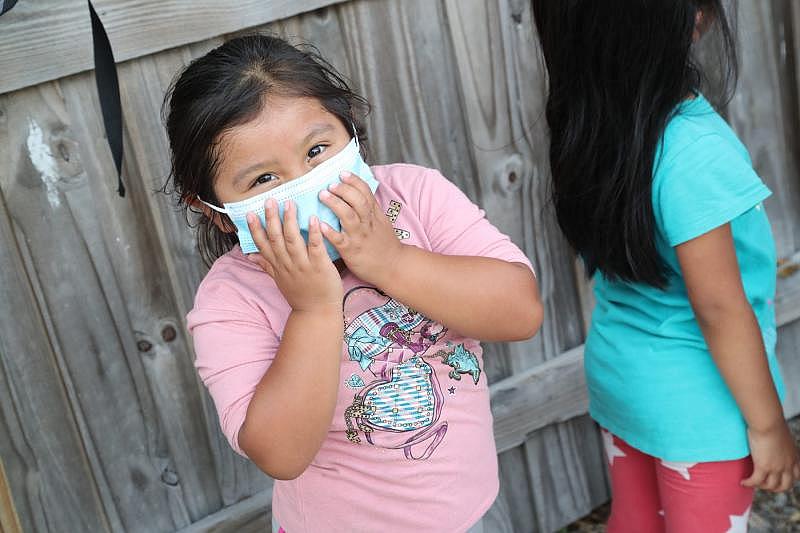
Yulisa and Zaira Hernandez in preschool at a Redlands Christian Migrant Association center in Dover, Florida. Their parents are migrant farmworkers, who kept the girls enrolled in preschool in order to prepare them for public school. ANDREA MELENDEZ/THE USA TODAY NETWORK-FLORIDA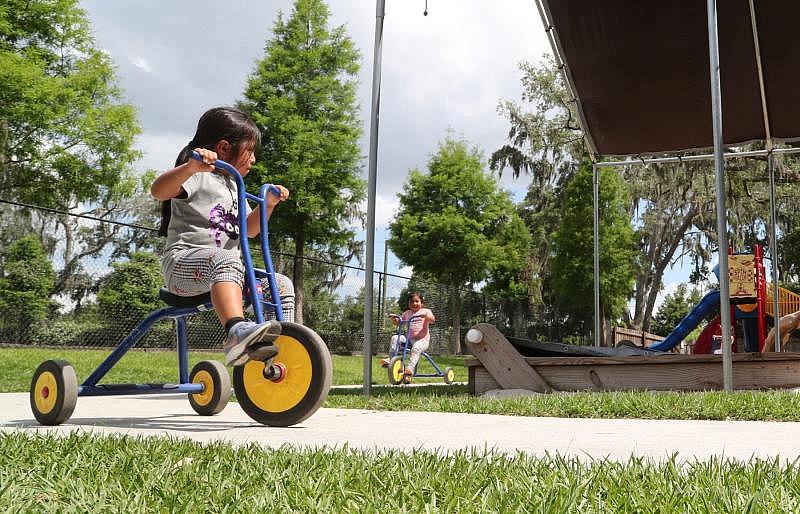
“They know what questions to ask,” said Damaris Boone, RCMA’s education and outcomes manager for early childhood. “They really are attuned because they’ve lived through it and they can take that on into public school systems.”
But when Florida schools opened in fall 2020, many migrant parents feared sending their children back into the classroom, where experts say learning outcomes are typically better. Mere months earlier, the virus tore through rural Florida communities, under-resourced in masks, testing and healthcare.
Florida towns with farmworker populations counted infection rates higher than the state average and up to three times more than nearby wealthier communities of retirees, according to a USA TODAY Network-Florida analysis of state data.
As of March, in Palm Beach County, rural South Bay had an infection rate three times that of seaside Jupiter, and Immokalee, with 26,600 people, counted the highest number of cases in Collier County while representing just 7% of the county’s population.
“We would have preferred the children lose a year of school than send them to school and lose them,” said Mynor Gabriel, a 33-year-old Immokalee migrant worker and father who waited to send his children back into the classroom until he felt assured schools were heeding virus prevention guidance.
Migrant students added work to schooling during the pandemic
Luz Vazquez turned the mushy strawberry, circled by flies, with a gloved hand to see if it was decent enough to pick for juice. The 17-year-old wore a hoodie to protect her from the brutal sun and jeans soiled at the knees. Her mother worked nearby.
After a full day in central Florida fields, Luz would return to the home her college-age brother helped her parents buy with the same sweat-heavy crop work she was doing.
Then her second shift began. Sometimes she’d grab a quick nap before chipping away at a long checklist from her three AP classes. She’d study until midnight, 2 at the latest, before she got up around 6 again.
“It was quite tiring, but I felt like I needed to. I wanted to help.”
Work could be another reason fewer migrant students enrolled.
“In hard times, these kids do help with the income of the family. When it’s about putting food on the table or having a roof over their heads, they have to make these hard decisions,” said Carol Mayo, Migrant Education Program supervisor for Hillsborough County Public Schools.
There were steep migrant enrollment dives – around 13% – in sixth and eighth grades during the pandemic. “It’s those middle-schoolers who are the ones they miss because they’re trying to hide from us and because they want to work,” said Dimas, migrant program coordinator for Collier.
Even while working, Vazquez excelled during virtual school, her GPA rising from 3.8 to 3.9. When summer came and farm work dried up, the family chose not to migrate to Michigan, where they typically pick blueberries. Instead, she worked with her dad in roofing.
Come late summer, she will return to Michigan, this time to attend college.
This school year, many families stayed longer before migrating or only one parent left so the other could stay with the children to finish. Migrants start heading north in April or May depending on the harvest work. Other families decided not to migrate.
To meet the need, Redlands Christian Migrant Association extended migrant education programs, which typically end in May, into June at several centers, said Boone, the education and outcomes manager. Overall, though, RCMA served 200 fewer students this year in free migrant Head Start programs, which typically draw waiting lists.
Roger Rosenthal, executive director of the D.C.-based nonprofit Migrant Legal Action Program, said Florida’s migrant enrollment loss likely had most to do with students “not attending school or not attending regularly because they didn’t have computers or internet access or an adequate space to attend virtually.”
He anticipated many students will return this fall. “Many farmworker parents regret the fact they didn’t get to complete their education and realize they’re doing farm work because they haven’t had enough schooling to do other things. They want their children to have a full range of opportunities.”
Even if migrant students weren’t attending school, they built grit and other learning skills, said an education expert who hopes teachers will acknowledge and build upon their strengths when they do return.
“They have these valuable skills. Now teachers need to leverage them,” said Ryan Pontier, assistant professor of bilingual education at Florida International University. “These are students who are already an important part of this country, and we have an opportunity to learn from them and their experiences.”
Moving forward, it will be critical for teachers to vary instruction and catch some students up without reinforcing stereotypes about certain groups of students, said Julie Sugarman, senior policy analyst for pre-K-12 education at the Migration Policy Institute. “I’m extra concerned for next year when classes get reconstituted to see what happens.”
Stress, uncertainty reflected in attendance
Jasmine Calderon drew motivation from teachers and mentors to successfully finish her senior year at Pahokee High in Palm Beach County. MELANIE BELL, THE PALM BEACH POST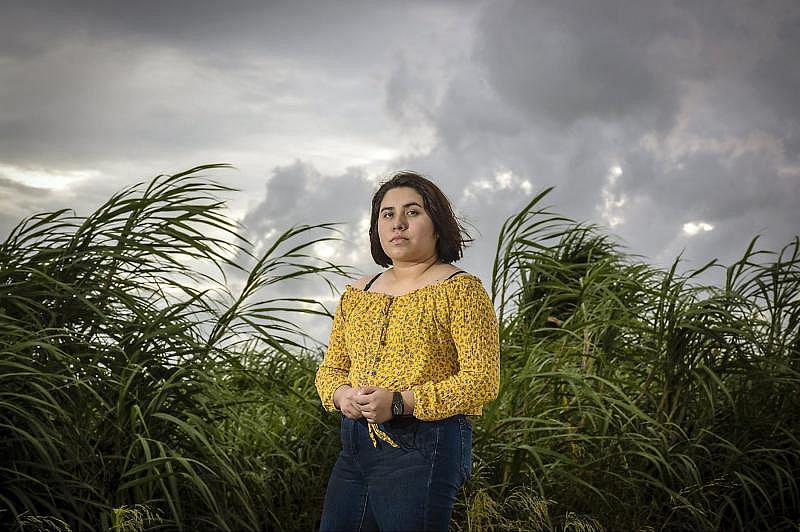
I can’t do this anymore.
Doubt welled in 18-year-old Jasmine Calderon’s mind several times throughout her senior year at Pahokee High.
Her father, the family’s main provider who worked in sugar cane, died from COVID-induced pneumonia in June 2020. She and her family grappled with grief and bills. Schoolwork provoked stress too. She was in the International Baccalaureate program and watched over her younger sister in virtual school while their mother was at work. In the backdrop thrummed her fear of losing another person she loved.
“Had I not already been on the right track since my eighth-grade year of middle school, I wouldn’t have had the motivation to begin with to do well my senior year,” Calderon said.
The pandemic amplified the insecure existence of migrant families. Children worried about their parents, essential workers who could not afford to stay home. They saw loved ones contract the virus and sometimes die.
Overcrowded housing in many farmworker communities made distancing stressful, if near impossible. In Immokalee, a hub for the nation’s winter tomatoes, more than 1 in 4 people live in crowded housing, about eight times the state and Collier average, according to Census data.
Several farmworker parents said the hardest part of the pandemic for them was making rent. And they’re still maimed financially. Their children have seen little luxuries evaporate, like a sweet treat or meals out. Undocumented immigrants were not eligible for federal stimulus checks. In many counties including Collier — when work was most scarce — they were excised from local rental assistance programs even when there was no federal requirement to do so.
For children, the pandemic brought on “a whole new level of stress that they’ve never experienced before,” said Javier Rosado, director of clinical research at Florida State University's Center for Child Stress & Health in Immokalee.
There was a “snowball effect” of hardships, he said.
Interviews over several months with migrant parents, students and school officials in Collier, Palm Beach, Hillsborough, Miami-Dade and Polk counties showed this to be acutely true, especially for mothers who do farm work. Like many working mothers, they shouldered extra childcare and suffered contracted wages during the pandemic.
Juliana's son stands with her outside their home in Immokalee. Juliana is an undocumented farmworker, and her family has struggled financially during the pandemic because of limited work and family members contracting COVID-19. ALEX DRIEHAUS/NAPLES DAILY NEWS/USA TODAY - FLORIDA NETWORK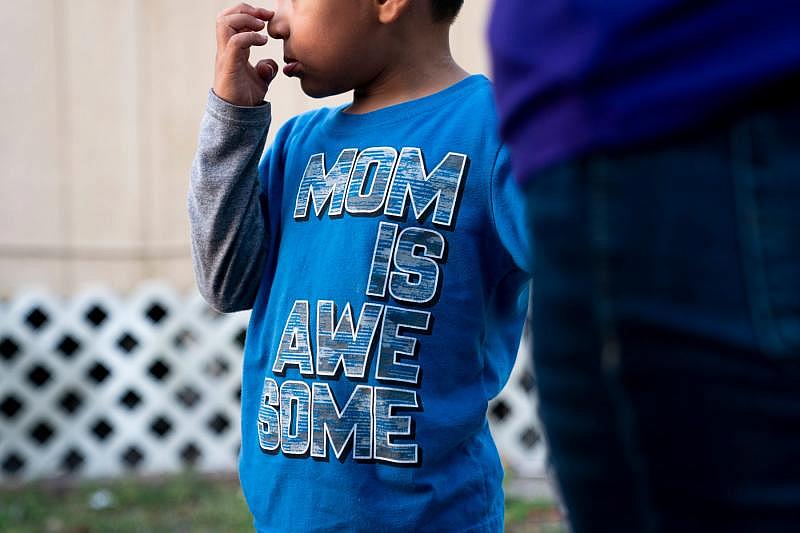
A friend loaned them money and they received help through a nonprofit, but they still owed $1,000 several months later.
“Where are we going to get the money to pay that back?” said the mother, Juliana, whom the USA TODAY Network - Florida is not fully identifying because she is undocumented.
Then there was the guilt of not sending as much money to alleviate the poverty of her older daughter and elderly parents in Guatemala. She returned to farm work, but it wasn’t as plentiful for women this season, she said. But she had few options: “I don’t know how to read or write.”
The months of uncertainty seeped into school life.
“It’s hard for educators to stop and not teach every standard, every goal that needs to be met. But this year we focused more on the emotional piece and the fact that many of our students needed that extra reminder that everything is going to be OK,” said Zulaika Quintero, principal of RCMA’s Immokalee Community School, where nearly half of the students are migrants.
Migrant advocates noted an erosion of motivation in some students.
“We have had an absentee problem,” said Dani Higgins, a Polk County migrant interventionist teacher. “Migrant families are already socially isolated, and I think this prolonged isolation for the students has not helped attendance.”
Statewide absenteeism rates are not yet available for this school year, but a top county for migrant students with that data showed a steep ascent.
As of late April, there was a 50% jump in the number of Hillsborough County migrant students counting 10 absences or more compared to the previous year. That’s about twice the rate for non-migrants.
Migrant students who were successful this past year said it helped to be already plugged into school life. They drew support from teachers and mentors.
“I knew that, hey, I have this reputation to uphold. I have this GPA to uphold. I knew I had to do better or at least be consistent,” said Calderon, who graduated as Pahokee High’s valedictorian. “I was blessed to have amazing teachers and mentors.”
Jasmine Calderon, Pahokee High School's valedictorian, delivers her commencement speech during graduation at the South Florida Fairgrounds. TIM STEPIEN/THE PALM BEACH POST
Some good news: In 2020, a greater percentage of Florida’s migrant students who made it to senior year finished. Migrant students graduated at about the same rate – 90% – as non-migrant students, an improvement for both groups but even more so for migrant students, whose graduation rate was about 82% the year before. Last year’s graduation rates improved across the state as officials waived some requirements because of the pandemic.
As of this spring, 17 of 20 migrant seniors in Mulberry in Polk County had been accepted into college, said Higgins, noting 15 of those students received around $1.5 million in scholarship and school-based aid.
“That’s my highlight,” Higgins said. “If I can get these seniors really engaged, it’s going to help me with my underclassmen as well and that has been the case.”
